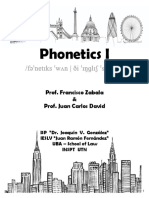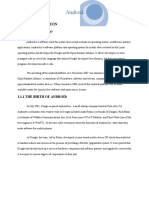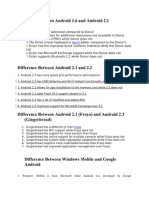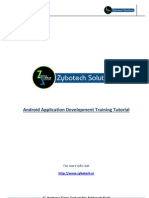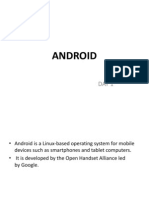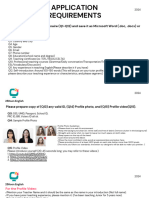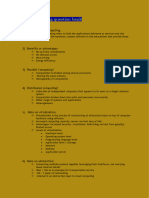Android: Next Generation Mobile Computing
Android: Next Generation Mobile Computing
Uploaded by
Suhasini BadamCopyright:
Available Formats
Android: Next Generation Mobile Computing
Android: Next Generation Mobile Computing
Uploaded by
Suhasini BadamOriginal Title
Copyright
Available Formats
Share this document
Did you find this document useful?
Is this content inappropriate?
Copyright:
Available Formats
Android: Next Generation Mobile Computing
Android: Next Generation Mobile Computing
Uploaded by
Suhasini BadamCopyright:
Available Formats
ANDROID
Next Generation Mobile Computing
Vignans Lara Institute of Technology and Sciences
B.Suhasini Rani 09FE1A0580 III/IV CSE
Suhasini.rani053@gmail.com
B.Varasri 09FE1A0588 III/IV CSE
b.varam20@gmail.com
Abstract Android is an operating system for mobile devices such as smart phones and tablet computers. It is d eveloped by the Open Handset Alliance led by Google. Google purchased the initial developer of the software, Android Inc., in 2005. The unveiling of the Android distribution on November 5, 2007 was announced with the founding of the Open Handset Alliance, a consortium of hardware, software, and telecommunication companies devoted to advancing open standards for mobile devices. Google released most of the Android code under the Apache License, a free software license The Android Open Source Project (AOSP) is tasked with the maintenance and further development of Android. Android consists of a kernel based on the Linux kernel, with middleware,libraries and APIs written in C. Android uses the Dalvik virtual machine with just-in-time compilation to run Dalvik dex-code (Dalvik Executable), which is usually translated from Java bytecode. Features of Android are Application framework, Dalvik virtual machine, Integrated browser, Optimized graphics, SQLite, Media support, GSM Telephony, Bluetooth, EDGE, 3G, and WiFi, Camera,
GPS, compass, and accelerometer, Rich development environment Android was listed as the best-selling smartphone platform worldwide with over 200 million Android devices in use by November 2011
Android Architecture The following diagram shows the major components of the Android operating system. Each section is described in more detail below.
Applications Android will ship with a set of core applications including an email client, SMS program, calendar, maps, browser, contacts, and others. All applications are written using the Java programming language. Application Framework By providing an open development platform, Android offers developers the ability to build extremely rich and innovative applications. Developers are free to take advantage of the device hardware, access location information, run background services, set alarms, add notifications to the status bar, and much, much more. Developers have full access to the same framework APIs used by the core applications. The application architecture is designed to simplify the reuse of components; any application can publish its capabilities and any other application may then make use of those capabilities (subject to security constraints enforced by the framework). This same mechanism allows components to be replaced by the user. Underlying all applications is a set of services and systems, including: A rich and extensible set of Views that can be used to build an application, including lists, grids, text boxes, buttons, and even an embeddable web browser Content Providers that enable applications to access data from other applications (such as Contacts), or to share their own data A Resource Manager, providing access to
non-code resources such as localized strings, graphics, and layout files A Notification Manager that enables all applications to display custom alerts in the status bar An Activity Manager that manages the lifecycle of applications and provides a common navigation backstack Libraries Android includes a set of C/C++ libraries used by various components of the Android system. These capabilities are exposed to developers through the Android application framework. Some of the core libraries are listed below: System C library - a BSD-derived implementation of the standard C system library (libc), tuned for embedded Linuxbased devices Media Libraries - based on PacketVideo's OpenCORE; the libraries support playback and recording of many popular audio and video formats, as well as static image files, including MPEG4, H.264, MP3, AAC, AMR, JPG, and PNG Surface Manager - manages access to the display subsystem and seamlessly composites 2D and 3D graphic layers from multiple applications LibWebCore - a modern web browser engine which powers both the Android browser and an embeddable web view
SGL - the underlying 2D graphics engine
3D libraries - an implementation based on OpenGL ES 1.0 APIs; the libraries use either hardware 3D acceleration (where available) or the included, highly optimized 3D software rasterizer FreeType - bitmap and vector font rendering SQLite - a powerful and lightweight relational database engine available to all applications Android Runtime Android includes a set of core libraries that provides most of the functionality available in the core libraries of the Java programming language. Every Android application runs in its own process, with its own instance of the Dalvik virtual machine. Dalvik has been written so that a device can run multiple VMs efficiently. The Dalvik VM executes files in the Dalvik Executable (.dex) format which is optimized for minimal memory footprint. The VM is register-based, and runs classes compiled by a Java language compiler that have been transformed into the .dex format by the included "dx" tool. The Dalvik VM relies on the Linux kernel for underlying functionality such as threading and low-levelmemory management. Linux Kernel Android relies on Linux version 2.6 for core system services such as security, memory management, process management, network stack, and driver model. The kernel also acts as an abstraction layer between the hardware
and the rest of the software stack. Dalvik Virtual machine The Dalvik virtual machine is a registerbased virtual machine, designed and written by Dan Bornstein with contributions from other Google engineers as part of the Android mobile phone platform. It is optimized for low memory requirements, and is designed to allow multiple VM instances to run at once, relying on the underlying operating system for process isolation, memory management and threading support. Dalvik is often referred to as a Java Virtual Machine, but this is not strictly accurate, as the bytecode on which it operates is not Java bytecode. Instead, a tool named dx, included in the Android SDK, transforms the Java Class files of Java classes compiled by a regular Java compiler into another class file format (the .dex format).
Features Handset layouts The platform is adaptable to larger, VGA, 2D graphics library, 3D graphics library based on OpenGL ES 2.0 specifications, and traditional smartphone layouts. Storage SQLite, a lightweight relational database, is used for data storage purposes.
Connectivity
Android supports connectivity technologies including GSM/EDGE, IDEN, CDMA, EVDO, UMTS, Bluetooth, Wi-Fi, LTE, NFC and WiMAX. Messaging SMS and MMS are available forms of messaging, including threaded text messaging and now Android Cloud To Device Messaging (C2DM) is also a part of Android Push Messaging service. Multiple language support Android supports multiple languages. Web browser The web browser available in Android is based on the open-source WebKit layout engine, coupled with Chrome's V8 JavaScript engine. The browser scores 100/100 on the Acid3 test on Android 4.0, however does have some rendering issues. Java support While most Android applications are written in Java, there is no Java Virtual Machine in the platform and Java byte code is not executed. Java classes are compiled into Dalvik executables and run on Dalvik, a specialized virtual machine designed specifically for Android and optimized for battery-powered mobile devices with limited memory and CPU. J2ME support can be provided via third-party applications. Media support Android supports the following audio/video/ still media formats: WebM, H.263, H.264 (in 3GP or MP4 container), MPEG-4 SP,
AMR, AMR-WB (in 3GP container), AAC, HE-AAC (in MP4 or 3GP container), MP3, MIDI, Ogg Vorbis, FLAC, WAV, JPEG, PNG, GIF, BMP. Streaming media support RTP/RTSP streaming (3GPP PSS, ISMA), HTML progressive download (HTML5 <video> tag). Adobe Flash Streaming (RTMP) and HTTP Dynamic Streaming are supported by the Flash plugin. Apple HTTP Live Streaming is supported by RealPlayer for Mobile, and by the operating system in Android 3.0 (Honeycomb). Additional hardware support Android can use video/still cameras, touchscreens, GPS, accelerometers, gyroscopes, barometers, magnetometers, dedicated gaming controls, proximity and pressure sensors, thermometers, accelerated 2D bit blits (with hardware orientation, scaling, pixel format conversion) and accelerated 3D graphics. Multi-touch Android has native support for multitouch which was initially made available in handsets such as the HTC Hero. The feature was originally disabled at the kernel level (possibly to avoid infringing Apple's patents on touch-screen technology at the time). Google has since released an update for the Nexus One and the Motorola Droid which enables multi-touch natively.
Bluetooth
Supports A2DP, AVRCP, sending files (OPP), accessing the phone book (PBAP), voice dialing and sending contacts between phones. Keyboard, mouse and joystick (HID) support is available in Android 3.1+, and in earlier versions through manufacturer customizations and third-party applications. Video calling Android does not support native video calling, but some handsets have a customized version of the operating system that supports it, either via the UMTS network (like the Samsung Galaxy S) or over IP. Video calling through Google Talk is available in Android 2.3.4 and later. Gingerbread allows Nexus S to place Internet calls with a SIP account. This allows for enhanced VoIP dialing to other SIP accounts and even phone numbers. Skype 2.1 offers video calling in Android 2.3, including front camera support. Multitasking Multitasking of applications is available. Voice based features Google search through voice has been available since initial release. Voice actions for calling, texting, navigation, etc. are supported on Android 2.2 onwards. Tethering Android supports tethering, which allows a phone to be used as a wireless/wired WiFi hotspot. Before Android 2.2 this was supported by third-party applications or manufacturer customizations. Screen capture
Android has native support for screenshot capture ability by pressing the power and volume buttons at the same time on an Android device. This native support came about with the release of Android's 4.0 (Ice Cream Sandwich) update which is first seen on the Galaxy Nexus smartphone. Previously Android did not feature native support for screen capturing which would have likely been due to security concerns. Previously, manufacturer and third-party customizations as well as using a PC connection (DDMS developer's tool) were the only known methods of capturing a screenshot on Android.
Applications Application security An example of app permissions in Android Market. Android applications run in a sandbox, an isolated area of the operating system that does not have access to the rest of the system's resources, unless access permissions are granted by the user when the application is installed. Before installing an application, Android Market displays all required permissions. A game may need to enable vibration, for example, but should not need to read messages or access the phonebook. After reviewing these permissions, the user can decide whether to install the application. Some Android malware incidents have been reported involving rogue applications on Android Market. In August 2010, Kaspersky
Lab reported detection of the first malicious program for Android, named TrojanSMS.AndroidOS.FakePlayer.a, an SMS trojan which had already infected a number of devices. In some cases applications which contained Trojans were hidden in pirated versions of legitimate apps. Google has responded by removing malicious apps from the Android Market, and remotely disabling them on infected devices.Security firms such as AVG Technologies and Symantec have released antivirus software for Android devices. Privacy Android smartphones have the ability to report the location of Wi-Fi access points, encountered as phone users move around, to build vast databases containing the physical locations of hundreds of millions of such access points. These databases form electronic maps to locate smartphones, allowing them to run apps like Foursquare, Latitude, Places, and to deliver locationbased ads. One design issue is that average users cannot monitor how applications access and use private and sensitive data (e.g. location and hardware ID numbers). Even during installation, permission checks do not often indicate to the user how critical services and data will be used or misused. Third party monitoring software such as TaintDroid, an academic research-funded project, can identify personal information sent from applications to remote servers.
Android is a disruptive technology, which was introduced initially on mobile handsets, but has much wider potential. References As the subject is quite new and there are no books and papers published yet, I wrote this report based on the information I found on these web pages 1.http://www.android.com/GoogleAndroid official webpage 2.http://www.OpenHandsetAlliance webpage 3.http://www.wikipedia.org 4.http://www.googleblog.blogspot.com/ Official Google Blog -
Conclusion
You might also like
- Gabriel Volpe - Practical FP in Scala A Hands-On Approach (2020)Document237 pagesGabriel Volpe - Practical FP in Scala A Hands-On Approach (2020)Michael EspeñaNo ratings yet
- Rurouni Kenshin - Her Most Beautiful SmileDocument2 pagesRurouni Kenshin - Her Most Beautiful Smileivshadow100% (8)
- Comparing Online and Offline Self-Disclosure A Systematic ReviewDocument10 pagesComparing Online and Offline Self-Disclosure A Systematic ReviewVu ThuNo ratings yet
- Phonetics 1 2020 BookletDocument320 pagesPhonetics 1 2020 BookletGaby ArredondoNo ratings yet
- Android Is A LinuxDocument5 pagesAndroid Is A Linuxvivaan2No ratings yet
- ABSTRACT: Android Is A Software Stack For Mobile Devices ThatDocument29 pagesABSTRACT: Android Is A Software Stack For Mobile Devices That12345mtp69% (13)
- Android TurorialDocument179 pagesAndroid TurorialSrinivas MahantiNo ratings yet
- Android Technology SeminarDocument31 pagesAndroid Technology SeminarArchie Srivastava0% (1)
- Android TurorialDocument216 pagesAndroid TurorialSrinivas MahantiNo ratings yet
- Android OSDocument46 pagesAndroid OSShylock DasNo ratings yet
- Android Overview: Rao VandanaDocument50 pagesAndroid Overview: Rao Vandanaajaj ansariNo ratings yet
- Android Seminar Report BodyDocument31 pagesAndroid Seminar Report BodyYedu100% (2)
- Android Seminar Report FinalDocument23 pagesAndroid Seminar Report FinalShivani GujralNo ratings yet
- Android SummaryDocument5 pagesAndroid SummaryMadhava Ram ParanandiNo ratings yet
- Android: 1.1. The Birth of AndroidDocument24 pagesAndroid: 1.1. The Birth of AndroidKonda RaveendrakumarNo ratings yet
- Mini Project Report On Android Technology With Sample CodeDocument37 pagesMini Project Report On Android Technology With Sample CodeShashank89% (80)
- AndroidDocument9 pagesAndroidSowjanya KotaNo ratings yet
- 1.1.1. Google Acquires Android IncDocument41 pages1.1.1. Google Acquires Android IncSubham SadraNo ratings yet
- AndroidDocument16 pagesAndroidShruthi ReddyNo ratings yet
- MAD Lab DocumentDocument32 pagesMAD Lab DocumentDhyan MohanNo ratings yet
- FulreprtDocument24 pagesFulreprtssomNo ratings yet
- K.Ramesh V Semester Reg No.1709151Document15 pagesK.Ramesh V Semester Reg No.1709151Ramesh GowdNo ratings yet
- 1.1 What Is ANDROID?Document24 pages1.1 What Is ANDROID?Geetha Reddy MNo ratings yet
- Mobile Operating System: BY S.Siddharth 07P71AO497Document26 pagesMobile Operating System: BY S.Siddharth 07P71AO497Siddharth SheshadriNo ratings yet
- QB Solution PT-1 MADDocument31 pagesQB Solution PT-1 MADAryan BuchakeNo ratings yet
- 1.1.1.google Acquires Android IncDocument26 pages1.1.1.google Acquires Android IncYogesh SoniNo ratings yet
- Umer Shahzad: Android Development Training JDKDocument23 pagesUmer Shahzad: Android Development Training JDKAamir ikramNo ratings yet
- Difference Between Android 1.6 and Android 2.1: FroyoDocument5 pagesDifference Between Android 1.6 and Android 2.1: FroyoNguru PrasadNo ratings yet
- Attendroid Using Android: Google Acquires Android IncDocument31 pagesAttendroid Using Android: Google Acquires Android IncSai SandeepNo ratings yet
- Android BasicDocument28 pagesAndroid BasicSri GayuNo ratings yet
- Android Application Development Training Tutorial: For More Info VisitDocument5 pagesAndroid Application Development Training Tutorial: For More Info VisitzybotechsolutionsNo ratings yet
- seminar-Anroid TechnologyDocument29 pagesseminar-Anroid TechnologyraginfotechdtgNo ratings yet
- Android ArchitectureDocument6 pagesAndroid ArchitectureBhaskar Rao PNo ratings yet
- What Is Android?: Open Handset AllianceDocument8 pagesWhat Is Android?: Open Handset AlliancePonnam ThulasiramNo ratings yet
- Computer Science & Engg - FileDocument39 pagesComputer Science & Engg - FilePushpendra KumarNo ratings yet
- Yc Yc Yc Yc Yc Yc Yc Yc Yc Yc Yc YcDocument7 pagesYc Yc Yc Yc Yc Yc Yc Yc Yc Yc Yc YcintriguegirlNo ratings yet
- An Evolution of Android Operating System and Its: K.Chinetha, J.Daphney Joann, A.ShaliniDocument4 pagesAn Evolution of Android Operating System and Its: K.Chinetha, J.Daphney Joann, A.ShalinisaimanobhiramNo ratings yet
- Independent Study Seminar On Android: Made By: Siddharth 09ITMG1086CSEDocument26 pagesIndependent Study Seminar On Android: Made By: Siddharth 09ITMG1086CSEsetia_tarikNo ratings yet
- Documentatuin 12 ADocument59 pagesDocumentatuin 12 AMr AneeshNo ratings yet
- Visvesraya Technological University BELGAUM-590018.: Department of Computer Science Android OSDocument12 pagesVisvesraya Technological University BELGAUM-590018.: Department of Computer Science Android OSSachin GowdaNo ratings yet
- Andriod OSDocument19 pagesAndriod OSعلي محمود علي عاصيNo ratings yet
- Unit No.1Document23 pagesUnit No.1Atharv KadamNo ratings yet
- An Introduction To: AndroidDocument14 pagesAn Introduction To: AndroidAbhiram HollaNo ratings yet
- Mad Unit-1Document69 pagesMad Unit-1Sumantika GandhiNo ratings yet
- Submitted By,: Vishnu M.S No: 42 S7 Cs CealDocument14 pagesSubmitted By,: Vishnu M.S No: 42 S7 Cs CealFazal SayyedNo ratings yet
- AndroidDocument20 pagesAndroidArun KumarNo ratings yet
- Android Architecture: Giteswar Goswami 19cs801014Document8 pagesAndroid Architecture: Giteswar Goswami 19cs801014Giteswar GoswamiNo ratings yet
- Android Day1Document27 pagesAndroid Day1arunkumarsaNo ratings yet
- Android: G. Sujit VarmaDocument18 pagesAndroid: G. Sujit VarmaSujit VarmaNo ratings yet
- Unit 2Document15 pagesUnit 2Chess BlogsNo ratings yet
- Best PDFDocument79 pagesBest PDFbalew ayalewNo ratings yet
- Android TechnologyDocument28 pagesAndroid TechnologysuchetanNo ratings yet
- What Is Android?: Open Handset AllianceDocument8 pagesWhat Is Android?: Open Handset AllianceSreenivas Reddy BNo ratings yet
- Unit-5 E-HealthDocument42 pagesUnit-5 E-HealthsuhasperumallaNo ratings yet
- Lecture # 01Document25 pagesLecture # 01MuneebNo ratings yet
- Seminar On Android: Sanjay Kr. Gupta 7 Sem., E.CDocument17 pagesSeminar On Android: Sanjay Kr. Gupta 7 Sem., E.CRahul AgarwalNo ratings yet
- Android: Application Framework Dalvik Virtual Machine Integrated BrowserDocument41 pagesAndroid: Application Framework Dalvik Virtual Machine Integrated Browseradithyaram011549No ratings yet
- What Is Android?Document13 pagesWhat Is Android?Bharat HazarikaNo ratings yet
- Mobile Application Development NotesDocument133 pagesMobile Application Development Notessephule1997No ratings yet
- MAD Chapter 1 NotesDocument11 pagesMAD Chapter 1 NotesSamyak HirapNo ratings yet
- Android Application DevelopmentDocument32 pagesAndroid Application DevelopmentAmi VermaNo ratings yet
- Android: An Open Platform For Mobile DevelopmentDocument18 pagesAndroid: An Open Platform For Mobile DevelopmentRevathi RevaNo ratings yet
- DP Presentation Summary-DineyDocument4 pagesDP Presentation Summary-DineyDiney MathewNo ratings yet
- Social Bookmarking Submission High Quality Submission Google Base Submission Classified SubmissionDocument16 pagesSocial Bookmarking Submission High Quality Submission Google Base Submission Classified SubmissionSEO TeamNo ratings yet
- Use The Past Form of Regular and Irregular Verbs: Elaine T. Arcangel Teacher IIIDocument18 pagesUse The Past Form of Regular and Irregular Verbs: Elaine T. Arcangel Teacher IIIELAINE ARCANGELNo ratings yet
- Rmarkdown Cheatsheet 2.0Document2 pagesRmarkdown Cheatsheet 2.0Weid Davinio PanDuroNo ratings yet
- Spanish LadyDocument4 pagesSpanish LadyBarbara Lee Vaquilar100% (1)
- DLP ENG6 Making ConnectionsDocument6 pagesDLP ENG6 Making ConnectionsMarietcho MacalisangNo ratings yet
- Kimetsu No Yaiba: Jharu GotougeDocument187 pagesKimetsu No Yaiba: Jharu Gotougewakena3551No ratings yet
- Single-Output Programmable DC Power Supply Programming Manual REV4Document80 pagesSingle-Output Programmable DC Power Supply Programming Manual REV4SửaĐồĐiệnNo ratings yet
- Harvard Author Date Style Guide - PRINT SOURCES 2016Document4 pagesHarvard Author Date Style Guide - PRINT SOURCES 2016landelizwidlaminiNo ratings yet
- CRW11 - 12 Q2 0405M - SG - Staging Modalities in DramaDocument25 pagesCRW11 - 12 Q2 0405M - SG - Staging Modalities in Dramamia4haloraNo ratings yet
- The Ontology and Epistemology of Social Reality in Accounting According To MattessichDocument9 pagesThe Ontology and Epistemology of Social Reality in Accounting According To MattessichfemisagoNo ratings yet
- Three Factors in Language DesignDocument22 pagesThree Factors in Language DesignmychiefNo ratings yet
- Homework 1 Real Analysis: Joshua Ruiter March 23, 2018Document7 pagesHomework 1 Real Analysis: Joshua Ruiter March 23, 2018홍석우No ratings yet
- Completo Punto 2Document8 pagesCompleto Punto 2REINALDO JUNIOR DE LA ROSA CERVANTESNo ratings yet
- Scenario 1 To 4Document5 pagesScenario 1 To 4Sneider AriasNo ratings yet
- 2 Matura 2015 Repetytorium PP Grammar Section 4 Test AbDocument2 pages2 Matura 2015 Repetytorium PP Grammar Section 4 Test AbŁukasz WnukNo ratings yet
- 53 PhungThiSon NA1301Document76 pages53 PhungThiSon NA1301Mã Mã NgốkNo ratings yet
- 1 Relative ClauseDocument8 pages1 Relative Clauseavin wongNo ratings yet
- 25Hoon-ApplicationRequirements 2024Document4 pages25Hoon-ApplicationRequirements 2024Beep BoopNo ratings yet
- Notting HillDocument4 pagesNotting Hillemre789No ratings yet
- Cloud Computing Question BankDocument3 pagesCloud Computing Question Bankneelpawar612No ratings yet
- Pro Engineer Commands PDFDocument2 pagesPro Engineer Commands PDFJahangir Ali100% (2)
- Unit - V PIG Hadoop & Big Data: Pig Latin. This Language Provides Various Operators Using Which ProgrammersDocument9 pagesUnit - V PIG Hadoop & Big Data: Pig Latin. This Language Provides Various Operators Using Which ProgrammersAbhay DabhadeNo ratings yet
- Seven Components of An Effective Classroom LPDocument4 pagesSeven Components of An Effective Classroom LPDONATELLA ADRIANA ANTICEVICNo ratings yet
- Dead Poets SocietyDocument1 pageDead Poets SocietyEscala, John KeithNo ratings yet
- Python 07 FilesDocument23 pagesPython 07 FilesAryan BhandariNo ratings yet
- ASCP Copy Plan Training - v1.0Document14 pagesASCP Copy Plan Training - v1.0Andrew DyerNo ratings yet



